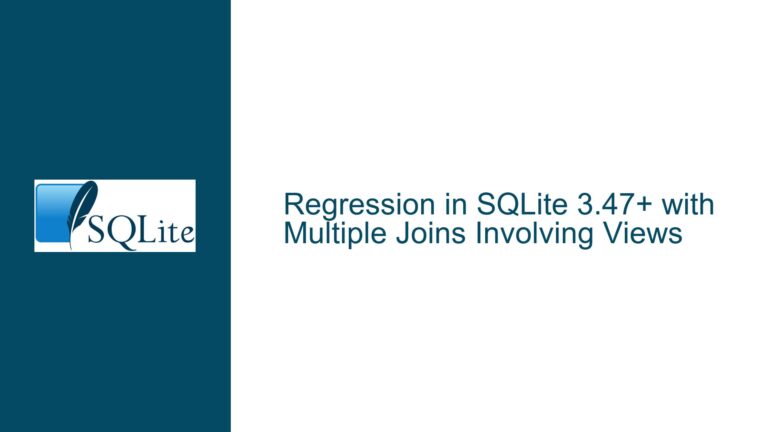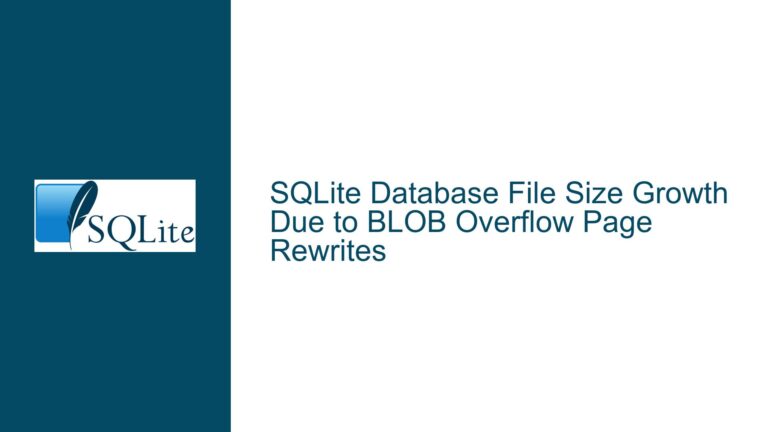Predicting SQLite Index B-Tree Pages and Degree Based on Entries and Byte Length
Understanding SQLite Index B-Tree Structure and Page Calculation
SQLite employs a B-tree structure for its indexes, which is a balanced tree data structure that maintains sorted data and allows for efficient insertion, deletion, and search operations. The B-tree in SQLite is designed to handle variable-length entries, which complicates the process of predicting the number of pages and the degree of the tree based solely on the number of entries and their byte lengths. Unlike textbook B-trees, where entries are of fixed size, SQLite’s B-tree must accommodate entries of varying sizes, leading to a dynamic and less predictable structure.
Each page in an SQLite B-tree can contain a variable number of entries, depending on the size of each entry. The size of an entry is influenced by the data it holds, and in the case of integers, SQLite uses a compact storage format where smaller integers consume fewer bytes. This variability means that the number of entries per page can range from just one to several thousand, making it challenging to predict the total number of pages without traversing the tree.
To understand the structure of an SQLite B-tree, one must consider the following components: the root page, internal pages, and leaf pages. The root page is the topmost page in the tree, internal pages are intermediate nodes that guide the search to the appropriate leaf page, and leaf pages contain the actual data entries. The depth of the tree is determined by the number of levels from the root to the leaves, and this depth can vary based on the distribution of entry sizes and the number of entries.
Given the complexity of SQLite’s B-tree structure, predicting the number of pages and the degree of the tree requires a deep understanding of the file format and the specific implementation details of SQLite’s B-tree. The file format specification provides detailed information on how pages are organized and how entries are stored, but applying this information to predict page counts and tree degree is non-trivial.
Challenges in Predicting B-Tree Pages and Degree Without Traversal
Predicting the number of pages and the degree of an SQLite B-tree without traversing the tree presents several challenges. The primary challenge is the variability in entry sizes. Since SQLite stores entries in a compact form, the byte length of each entry can vary significantly, especially when dealing with integers. Smaller integers require fewer bytes, while larger integers require more. This variability means that the number of entries that can fit on a single page is not constant and cannot be easily predicted without knowing the exact size of each entry.
Another challenge is the dynamic nature of the B-tree structure. As entries are inserted or deleted, the tree may reorganize itself to maintain balance. This reorganization can affect the number of pages and the degree of the tree, making it difficult to predict these values based solely on the initial number of entries and their byte lengths. Additionally, SQLite’s use of overflow pages for large entries further complicates the prediction process, as these pages are not part of the main B-tree structure but are still necessary for storing the data.
The depth of the B-tree is also influenced by the distribution of entry sizes. A tree with many small entries may have a different depth compared to a tree with fewer but larger entries. This variability in depth adds another layer of complexity to the prediction process, as it affects the overall structure of the tree and the number of pages required to store the data.
Given these challenges, it is clear that predicting the number of pages and the degree of an SQLite B-tree without traversing the tree is not straightforward. While it may be possible to make reasonable estimates using the file format specification and other documentation, these estimates are unlikely to be accurate without detailed knowledge of the specific data being stored and the exact implementation of SQLite’s B-tree.
Practical Approaches to Estimate B-Tree Pages and Degree
While predicting the exact number of pages and the degree of an SQLite B-tree without traversing the tree is challenging, there are practical approaches that can provide reasonable estimates. One such approach is to use the SQLite file format specification to understand how pages are organized and how entries are stored. By studying the file format, one can gain insights into the factors that influence the number of pages and the degree of the tree, such as the size of each entry and the structure of the B-tree.
Another practical approach is to analyze the B-tree source code, which contains detailed comments and explanations of the implementation. By examining the source code, one can understand how SQLite handles variable-length entries and how it manages the B-tree structure. This knowledge can be used to develop algorithms or models that estimate the number of pages and the degree of the tree based on the number of entries and their byte lengths.
Additionally, the sqlite3_analyzer tool can be used to verify the accuracy of any estimates or models developed. This tool provides detailed information about the structure of an SQLite database, including the number of pages, the depth of the B-tree, and the distribution of entry sizes. By comparing the output of sqlite3_analyzer with the estimates generated by a model, one can assess the validity of the model and make adjustments as necessary.
It is also important to consider the compact storage format used by SQLite for integers, as this affects the byte length of each entry. Smaller integers require fewer bytes, while larger integers require more. This variability must be taken into account when developing models or algorithms to estimate the number of pages and the degree of the tree.
In conclusion, while predicting the exact number of pages and the degree of an SQLite B-tree without traversing the tree is difficult, practical approaches such as studying the file format, analyzing the source code, and using tools like sqlite3_analyzer can provide reasonable estimates. These approaches require a deep understanding of SQLite’s B-tree implementation and the factors that influence its structure, but they offer a viable way to make informed predictions without the need for full traversal.






